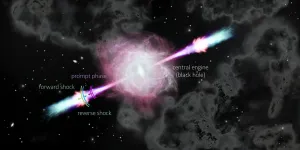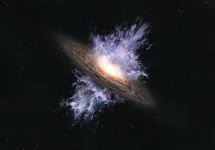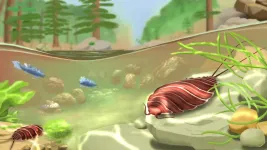Ozone pollution has increased in Antarctica
2021-06-16
(Press-News.org) Ozone is a pollutant at ground level, but very high in the atmosphere's "ozone layer," it absorbs damaging ultraviolet radiation. Past studies have examined ozone levels in the Southern Hemisphere, but little is known about levels of the molecule in Antarctica over long periods. Now, researchers reporting in ACS' Environmental Science & Technology have analyzed more than 25 years of Antarctic data, finding that concentrations near the ground arose from both natural and human-related sources.
Ozone gas has a sharp or acrid scent that sometimes accompanies smog or summer storms. It forms when sunlight reacts with gases produced by industrial and transportation activities, biomass burning or with naturally produced gases originating from lightning and microorganisms. However, when sunlight is very strong, it breaks down the molecule. Most ozone resides about 9-18 miles above Earth in the ozone layer, an atmospheric band within the stratosphere that protects the Earth from harmful UV radiation. But ozone in the lower atmosphere, or troposphere, is harmful and causes smog and throat and lung irritation. It's also a concern because the molecule traps heat 1,000 times better than carbon dioxide, and therefore, can have a large impact on global warming. While previous researchers have shown the rise of ozone in the troposphere across the Southern Hemisphere, there has not been a regional study reported for the remote Antarctic continent over a long period. So, Jayanarayanan Kuttippurath and colleagues wanted to use measurements made over Antarctica to determine where the ozone comes from and how levels have changed over time.
The researchers compiled ozone data measured between 1992 and 2018 at ground level and through the atmosphere, from the lower atmosphere into the ozone layer, at eight stations across Antarctica. Their analyses showed the amount of ozone throughout the troposphere was lowest during December, January and February, corresponding to summer in the Southern Hemisphere when the sun is intense enough that it breaks apart more ozone than it creates. Dominant sources of ozone were both natural -- from snow-pack on the large plateau in Eastern Antarctica and air mixing from the upper stratosphere to the troposphere -- and from humans, as some originated from the southern tip of South America. The researchers also found that ozone at ground level had risen up to 0.14 ppb per year over the 26 years that were reviewed, even when accounting for seasonal and natural patterns. Because of ozone's ability to hold heat near Earth's surface, the increasing trend could have negative impacts on the region in the future, the researchers say.
INFORMATION:
The authors acknowledge funding from the national bodies (U.S., Argentina, India, Italy and Germany) that operate and maintain the ozone measurement facilities. They specifically acknowledge support from the Indian Institute of Technology Kharagpur, Indian National Centre for Ocean Information Services, Hyderabad and Ministry of Earth Science; Ministry of Education India; Indian Department of Science & Technology; University of Colorado; National Oceanic & Atmospheric Administration; Italian National Antarctic Research Program (PNRA) Projects; and Alfred Wegener Institute.
The paper's abstract will be available on June 16 at 8 a.m. Eastern time here: https://pubs.acs.org/doi/abs/10.1021/acs.est.0c08491
The American Chemical Society (ACS) is a nonprofit organization chartered by the U.S. Congress. ACS' mission is to advance the broader chemistry enterprise and its practitioners for the benefit of Earth and all its people. The Society is a global leader in promoting excellence in science education and providing access to chemistry-related information and research through its multiple research solutions, peer-reviewed journals, scientific conferences, eBooks and weekly news periodical Chemical & Engineering News. ACS journals are among the most cited, most trusted and most read within the scientific literature; however, ACS itself does not conduct chemical research. As a leader in scientific information solutions, its CAS division partners with global innovators to accelerate breakthroughs by curating, connecting and analyzing the world's scientific knowledge. ACS' main offices are in Washington, D.C., and Columbus, Ohio.
To automatically receive news releases from the American Chemical Society, contact newsroom@acs.org.
Follow us: Twitter | Facebook
ELSE PRESS RELEASES FROM THIS DATE:
2021-06-16
Microplastic pollution of waterways has become a huge concern, with the tiny pieces of plastic entering food webs and potentially having harmful effects on animals and people. In addition, microplastics can act as breeding grounds for antibiotic-resistant bacteria. Now, researchers reporting in Environmental Science & Technology have analyzed antibiotic-resistance genes (ARGs) on five types of microplastics at different locations along the Beilun River in China, finding much higher abundances in urban than rural regions.
In rivers, major sources of microplastics include textile fibers from laundering, water bottle fragments, and films from bags and wrappers. Also prevalent in ...
2021-06-16
An international team of scientists, led by astrophysicists from the University of Bath in the UK, has measured the magnetic field in a far-off Gamma-Ray Burst, confirming for the first time a decades-long theoretical prediction - that the magnetic field in these blast waves becomes scrambled after the ejected material crashes into, and shocks, the surrounding medium.
Black holes are formed when massive stars (at least 40 times larger than our Sun) die in a catastrophic explosion that powers a blast wave. These extremely energetic events drive out material at velocities ...
2021-06-16
Researchers using the Atacama Large Millimeter/submillimeter Array (ALMA) discovered a titanic galactic wind driven by a supermassive black hole 13.1 billion years ago. This is the earliest-yet-observed example of such a wind to date and is a telltale sign that huge black holes have a profound effect on the growth of galaxies from the very early history of the Universe.
At the center of many large galaxies hides a supermassive black hole that is millions to billions of times more massive than the Sun. Interestingly, the mass of the black hole is roughly proportional to the mass ...
2021-06-16
The old cousins of the common woodlice were crawling on Irish land as long as 360 million years ago, according to new analysis of a fossil found in Kilkenny.
The research, published today (00.01 Wednesday 16 June) in the science journal Biology Letters, used state-of-the-art modern imaging technology to create a new picture of the Oxyuropoda - a land-based creature larger than the modern woodlice - using a fossil found in Kiltorcan, Co Kilkenny in 1908.
Lead researcher Dr Ninon Robin, a postdoctoral researcher at University College Cork's (UCC) School of Biological, Earth and Environmental Sciences said that their work advances science's understanding of when land-dwelling species of crustaceans roamed the earth, and what they looked like.
Dr Robin said:
"Woodlice, ...
2021-06-16
Québec produces more strawberries than any other Canadian province. Strawberries are delicate and difficult to keep fresh. In response to this challenge, Monique Lacroix, a professor at at the Institut national de la recherche scientifique (INRS), and her team have developed a packaging film that can keep strawberries fresh for up to 12 days. The team's findings on how this film protects against mould and certain pathogenic bacteria have been published in Food Hydrocolloids.
The innovative film is made of chitosan, a natural molecule found in shellfish shells. This food industry by-product contains key antifungal properties ...
2021-06-16
Thirty state-of-the-art IPCC-climate models predict dramatically different climates for the Northern Hemisphere, especially Europe. An analysis of the range of responses now reveals that the differences are mostly down to the individual model's simulations of changes to the North Atlantic ocean currents and not only - as normally assumed - atmospheric changes. The work, by Katinka Bellomo, National Research Council of Italy, Institute of Atmospheric Sciences and Climate, and colleagues is published today in Nature Communications and is part of the European ...
2021-06-16
A study led by Fernando Colchero, University of Southern Denmark and Susan Alberts, Duke University, North Carolina, that included researchers from 42 institutions across 14 countries, provides new insights into the aging theory "the invariant rate of ageing hypothesis", which states that every species has a relatively fixed rate of aging.
- Human death is inevitable. No matter how many vitamins we take, how healthy our environment is or how much we exercise, we will eventually age and die, said Fernando Colchero.
He is an expert in applying statistics and mathematics to population biology and an associate professor at Department of Mathematics and Computer Science, University of Southern Denmark.
"We were able to shed light on the invariant rate of ageing hypothesis by combining ...
2021-06-16
Teachers play a key role in supporting children's development in early childhood education classrooms such as Head Start. Research shows significant associations between teachers' depressive symptoms and their students' social and emotional development. However, little research has focused on the associations between teachers' depressive symptoms and academic outcomes of preschoolers from low-income families. Specifically, one important pathway that has not been examined is whether teacher depressive symptoms have implications for the quality of family-teacher relationships. This in turn could affect how supportive parents ...
2021-06-16
An herbicide widely used in agriculture, forestry and other applications can cause deleterious effects on the reproductive health of a common perennial plant found in forests in British Columbia, Canada. Researchers reported in the journal END ...
2021-06-16
Despite rapid development of electric vehicles (EVs), the safety of the lithium-ion (Li-ion) batteries remains a concern as they are as a fire and explosion risk. Among the various approaches to tackle this issue, Korean researchers have used semiconductor technology to improve the safety of Li-ion batteries. A research team from the Korea Institute of Science and Technology (KIST) led by Dr. Joong Kee Lee of the Center for Energy Storage Research has succeeded in inhibiting the growth of dendrites, crystals with multiple branches that cause EV battery fires by forming protective semiconducting passivation layers on the surface of Li electrodes.
When ...
LAST 30 PRESS RELEASES:
[Press-News.org] Ozone pollution has increased in Antarctica




